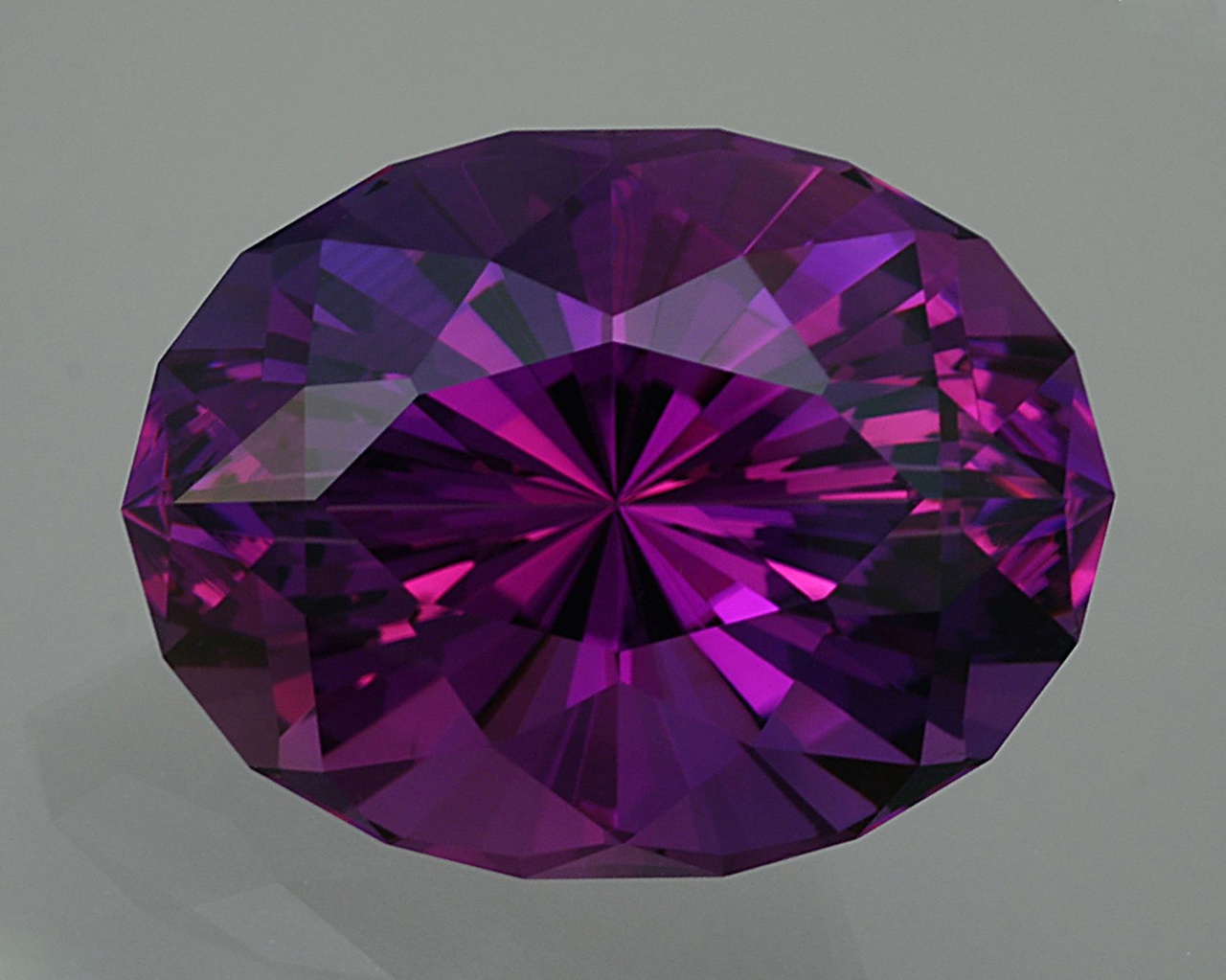Meaning
Amethyst, derived from the Greek word “amethystos,” meaning “not intoxicated,” has a rich history steeped in myth, symbolism, and cultural significance.
The ancient Greeks believed that amethyst possessed magical properties that could ward off drunkenness. They associated it with Bacchus, the god of wine, and often wore it as protection against the intoxicating effects of alcohol.
In Roman culture, amethyst was highly valued for its beauty and purported protective qualities. Roman soldiers carried amulets made from amethyst to ensure victory in battle.
Purple hues have long been associated with royalty and power throughout history. The color amethyst, ranging from pale lilac to deep violet, evokes a sense of nobility and regality.
In the medieval era, amethyst was considered one of the most precious gemstones. It was often used in religious artifacts and adornments worn by high-ranking clergy.
During the Renaissance, amethyst continued to be prized for its beauty and symbolic meaning. It was believed to promote spiritual awareness and enhance intuition.
Throughout history, amethyst has been found in various parts of the world, including Brazil, Uruguay, Zambia, and Russia. Its enduring popularity stems from its unique color, durability, and captivating symbolism.
The name “Amethyst” originates from the ancient Greek word “amethystos,” meaning “non-intoxicated.”
This stems from a long-held belief that amethyst had the power to prevent intoxication.
Ancient Greeks believed wearing amethyst could protect against drunkenness, and it was often incorporated into wine cups and other vessels associated with drinking.
This association likely arose from its deep purple hue, reminiscent of grapevines and wine.
Throughout history, amethyst has been linked to various symbolic meanings, extending beyond its connection to sobriety.
In ancient Rome, amethyst was associated with royalty and power, believed to be a gift from the gods.
Its purple color was often seen as a symbol of wealth, nobility, and spiritual enlightenment.
In medieval times, amethyst was thought to ward off evil spirits and protect against nightmares.
It was also associated with chastity and purity due to its association with the Virgin Mary.
In many cultures, amethyst is still seen as a stone of peace, intuition, and spiritual awareness.
It is believed to promote clarity of mind, enhance meditation, and connect individuals to their inner wisdom.
Origin
Amethyst gets its name from the Greek word “amethystos,” meaning “not intoxicated.” This stems from an ancient belief that wearing amethyst could prevent drunkenness.
This association with sobriety likely originated in ancient Greece, where amethyst was a popular gemstone. Greek myths tell of Bacchus, the god of wine, who became enraged by his lack of recognition as a divinity and sought revenge on mortals. Amethysts were said to be turned from clear quartz when Bacchus’ wrath transformed a nymph into a crystal.
The Romans adopted and expanded upon these Greek beliefs, incorporating amethyst into their own mythology and religious practices. The Romans revered amethyst for its supposed protective powers against intoxication and other vices.
Amethyst was highly sought after in both cultures and used in jewelry, carvings, and vessels. It adorned the attire of emperors and commoners alike, a testament to its widespread appeal and symbolic significance.
The name “Amethyst” originates from the Greek word “amethystos,” meaning “not intoxicated.” This etymology reflects ancient beliefs about the stone’s purported ability to prevent drunkenness.
Medieval Europe held a profound association with spirituality, and this deeply influenced its understanding and use of amethyst.
Here are some key aspects:
- Symbolism of Purity and Sobriety: Amethyst was believed to possess purifying qualities, both physically and spiritually. Its vibrant purple hue was associated with royalty, piety, and spiritual enlightenment. It was seen as a stone that could ward off temptation and promote temperance.
- Use in Religious Contexts: The amethyst was frequently incorporated into religious artifacts and adornments. It was used in the crafting of chalices, reliquaries, and other liturgical objects. Some believed it possessed divine power and could aid in prayer and meditation.
- Protection Against Evil and Negative Energies: Amethyst was thought to be a powerful talisman against evil spirits and negative energies. It was often worn as an amulet or carried on the person for protection during travel or times of hardship.
- Connection to the Virgin Mary: In Christian tradition, amethyst was associated with the Virgin Mary. Its purple color symbolized her regal status and spiritual purity. It was believed to embody her virtues of chastity, devotion, and grace.
The enduring association between amethyst and spirituality in Medieval Europe highlights its significant place within the cultural and religious landscape of the time.
History
Amethyst, with its captivating purple hues, has captivated humanity for millennia. Its name, a derivative of the Greek word “amethystos,” meaning “not intoxicated,” reflects an ancient belief in its power to ward off intoxication.
Legends abound about amethyst’s origins. One tale recounts how Dionysus, the Greek god of wine, became enraged by someone who had rejected his offerings. In a fit of fury, he sent a monstrous lion to terrorize the countryside. The goddess Diana intervened, transforming the lion into a fearsome creature with purple claws and teeth.
Amethyst’s association with royalty is deeply rooted in history. Egyptians prized the stone, incorporating it into jewelry, amulets, and even burial practices. Ancient Romans believed amethyst possessed healing properties and adorned their courts with its regal beauty.
The Middle Ages witnessed a surge in amethyst’s popularity. It became a symbol of piety and was frequently used in religious artifacts, reflecting its association with spiritual purity and temperance.
In the Renaissance, amethyst experienced a revival as artists and craftsmen embraced its vibrant color and intricate facets. Its use in jewelry flourished, and it was highly sought after by nobility and royalty.
Throughout history, amethyst has been revered for its beauty, metaphysical properties, and cultural significance. From ancient myths to medieval cathedrals and Renaissance masterpieces, this purple gem has left an indelible mark on human civilization.
Amethyst, with its mesmerizing purple hues, has captivated humans for millennia. Its name, derived from the Greek word “amethystos,” meaning “not intoxicated,” reflects an ancient belief that the gemstone possessed the power to ward off drunkenness.
The Greeks associated amethyst with Dionysus, their god of wine and revelry. They believed that wearing amethyst jewelry would prevent intoxication and promote sobriety.
Throughout history, amethyst has been highly prized for its beauty and perceived mystical properties. Ancient Egyptians valued it as a symbol of royalty and power, incorporating it into their tombs and sacred artifacts. In Roman times, amethyst was believed to enhance mental clarity and courage, often used in jewelry worn by warriors.
The medieval period saw the association of amethyst with spirituality and religious devotion. It became a popular gemstone for ecclesiastical use, adorning chalices, reliquaries, and other liturgical objects.
In modern times, amethyst continues to be a beloved gemstone cherished for its aesthetic appeal and diverse applications.
Amethyst is widely used in jewelry, from delicate earrings and necklaces to bold rings and bracelets. Its calming purple shades complement various metals and gemstones, making it a versatile choice for both classic and contemporary designs.
Beyond adornment, amethyst finds its place in spiritual practices and alternative therapies. It is believed to promote relaxation, peacefulness, and emotional balance. Amethyst crystals are often used in meditation and energy healing.
In recent years, there has been a growing interest in using amethyst for its purported metaphysical properties. Some believe that it can enhance intuition, psychic abilities, and spiritual awareness.
- Best LeadsGorilla Alternatives for 2025 - April 26, 2025
- Best Overloop Alternatives for 2025 - April 25, 2025
- Best Lead411 Alternatives for 2025 - April 25, 2025


